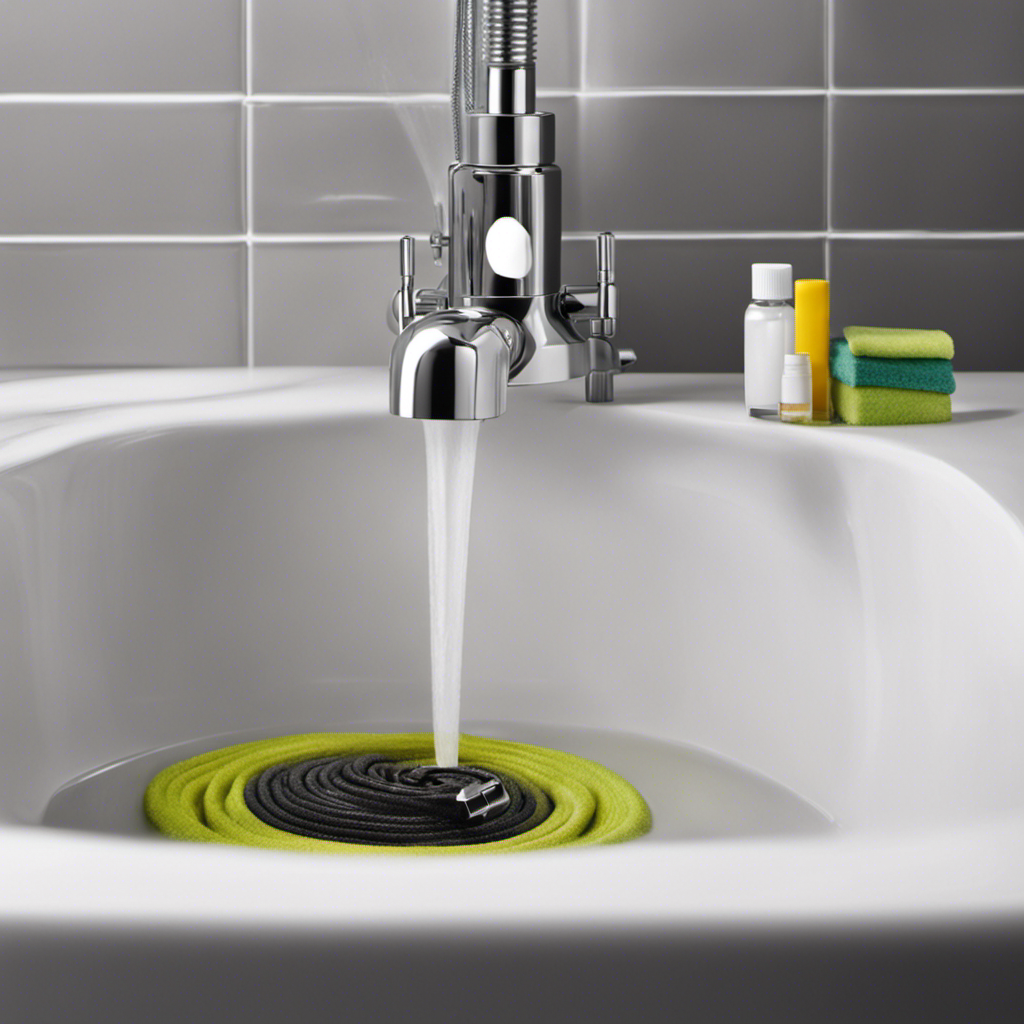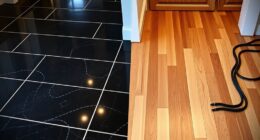Drain worms, those pesky larvae that transform into flies, can quickly become a nuisance in showers and drains. With their preference for moisture and organic matter, clogged drains provide the perfect breeding grounds.
To combat these unwelcome guests, routine maintenance is key. By using a mixture of soda and vinegar, fixing leaks, and ensuring proper bathroom ventilation, homeowners can prevent drain worm infestations.
If the issue persists, there are effective methods, such as hot water, bleach, and enzymatic drain cleaners, to remove drain worm larvae. Regular cleaning and maintenance of drains will keep these bothersome pests at bay.
Key Takeaways
- Drain flies lay eggs in areas with excess moisture, such as showers.
- Clogged drains with stagnant dirty water and organic matter are ideal breeding grounds for drain worms.
- Routine maintenance, such as using a soda and vinegar mixture periodically, can help prevent drain fly infestations in showers.
- If the issue persists, it is recommended to call a plumber for assistance with underlying issues causing drain fly recurrence.
Identifying Drain Worms in Showers
Drain worms in showers can be identified by the presence of small moths and black larvae around the drain. These black worms are actually drain fly larvae, which will transform into drain flies within a few weeks. Drain flies are also known as drain moths, drain flies, and sewer flies. If not handled, they will grow wings and buzz around.
When you notice small moths around a drain, it indicates the presence of drain fly larvae. To prevent drain worm infestations, it is important to address the causes. Drain flies lay eggs in areas with excess moisture, and their larvae thrive in clogged drains with stagnant dirty water and organic matter.
Prevent infestations by practicing routine maintenance, fixing any dripping shower heads or leaky valves, using drain covers or stoppers for unused showers or sinks, and maintaining good bathroom ventilation to prevent moisture buildup.
Causes and Prevention of Drain Worm Infestations
Excess moisture in bathroom areas is a primary cause for the presence of drain worms. These small black worms, also known as drain fly larvae, thrive in environments with organic matter and water. To prevent drain worm infestations, it is important to avoid common mistakes and watch out for signs of an infestation.
- Avoid neglecting routine maintenance of drains, as clogged drains with stagnant water and organic matter create ideal breeding grounds for drain worms.
- Do not ignore dripping shower heads or leaky valves, as they create stagnant water that attracts drain flies.
- Don’t forget to use drain covers or stoppers for unused showers or sinks to prevent drain flies from laying eggs.
- Ensure good bathroom ventilation to prevent moisture buildup, as excess moisture attracts drain flies.
Signs of a drain worm infestation to watch out for include small moths flying around drains and black worms in the shower or sink. By following these preventive measures and being aware of the signs, you can effectively prevent drain worm infestations in your bathroom.
Effective Methods to Remove Drain Worms
Using hot water is an effective method to drown and wash away drain worms. These natural remedies can be easily implemented to remove drain worms from showers and prevent infestations.
Regular drain maintenance is crucial in preventing the growth of drain worms. Hot water can be poured down the drain to kill and remove drain worms. The heat from the water suffocates the worms and flushes them away. This method is effective because it does not involve the use of harmful chemicals or pesticides.
It is important to regularly clean and maintain drains to prevent drain worm infestations. By keeping drains free of clogs and stagnant water, the breeding grounds for drain worms are eliminated. Regular maintenance also ensures that any potential issues are addressed promptly, reducing the risk of recurring infestations.
Additional Information on Drain Flies and Prevention Tips
Maintaining proper hygiene and routine maintenance are key steps in preventing future infestations of drain flies.
-
Drain fly life cycle: It starts with the female laying eggs in areas with excess moisture. These eggs then transform into drain fly larvae, also known as drain worms. The larvae need organic matter and water to thrive and will grow wings if not handled, becoming adult drain flies.
-
Common misconceptions about drain worms: Many people mistake drain fly larvae for black worms. They are also commonly referred to as drain moths, drain flies, and sewer flies. Small moths around a drain indicate the presence of drain fly larvae.
To prevent drain fly infestations, it is important to practice routine maintenance. This includes ensuring drains are free of clogs by using a soda and vinegar mixture periodically, fixing any dripping shower heads or leaky valves that create stagnant water, using drain covers or stoppers for unused showers or sinks, and maintaining good bathroom ventilation to prevent moisture buildup.
Maintaining Drain Hygiene to Prevent Future Drain Worm Infestations
Regular cleaning and hygiene practices in the bathroom are essential for preventing future infestations of drain worms. The importance of regular drain maintenance cannot be overstated when it comes to keeping these pests at bay.
One of the common sources of excess moisture in showers is leaky shower heads or valves that create stagnant water. This stagnant water provides the ideal environment for drain flies to lay their eggs and for drain fly larvae to thrive. To prevent this, it is crucial to fix any dripping shower heads or leaky valves promptly.
Additionally, maintaining good bathroom ventilation is essential to prevent moisture buildup. By practicing routine maintenance and addressing sources of excess moisture, you can effectively prevent future infestations of drain worms in your shower.
Frequently Asked Questions
How Long Does It Take for Drain Fly Larvae to Transform Into Drain Flies?
Drain fly larvae transform into drain flies within a few weeks. To prevent drain fly infestations, regularly maintain drains, use a soda and vinegar mixture, fix leaks, and ensure good ventilation.
Can Drain Worms Survive in Areas With Low Moisture Levels?
Drain worms, also known as drain fly larvae, require moisture to survive and thrive. In areas with low moisture levels, such as dry drains, it is unlikely that drain worms will be able to survive.
Are Drain Fly Larvae Harmful to Humans?
Drain fly larvae, commonly known as drain worms, are unsanitary but not harmful to humans. However, their presence indicates poor sanitation and hygiene. Proper drain fly control and maintenance practices are essential to prevent health risks associated with these pests.
Are There Any Natural Remedies to Prevent Drain Worm Infestations?
There are natural remedies to prevent drain worm infestations. Effective ways to get rid of drain worms without chemicals include using vinegar, baking soda, hot water, and enzymatic drain cleaners.
What Should I Do if the Issue of Drain Worms Persists Despite Using the Suggested Removal Methods?
If the issue of drain worms persists despite using the suggested removal methods, the individual can consider alternative solutions such as using stronger chemical drain cleaners. However, if the problem continues, it is advisable to seek professional help from a plumber.
Conclusion
In conclusion, drain worms, also known as drain fly larvae, can be a common nuisance in showers and drains. It is important to identify the signs of infestation and take preventive measures to avoid their presence.
Regular cleaning, using a soda and vinegar mixture, and fixing any leaks or dripping shower heads can help prevent drain worm infestations. If an infestation does occur, there are various effective methods to remove the larvae.
One interesting statistic to note is that a single female drain fly can lay up to 200 eggs at a time, highlighting the importance of proactive maintenance to prevent future infestations.
By maintaining proper drain hygiene, individuals can ensure a clean and pest-free showering experience.










